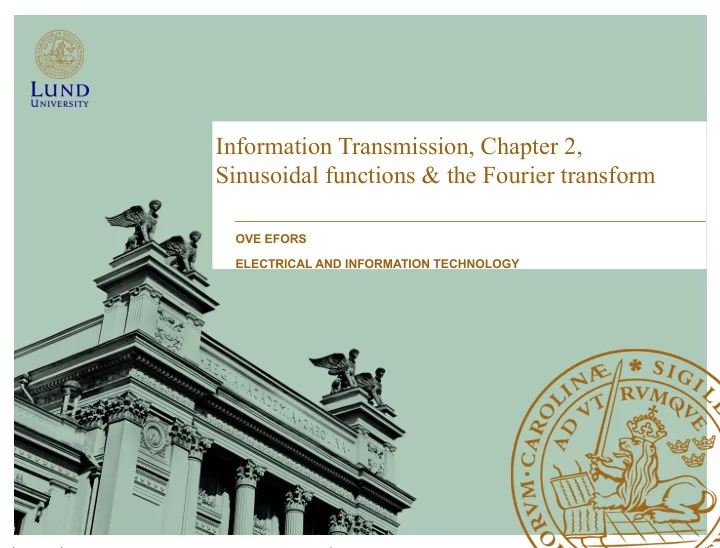

Information Transmission, Chapter 2, Sinusoidal functions & the Fourier transform OVE EFORS ELECTRICAL AND INFORMATION TECHNOLOGY
Learning outcomes The student should ● understand how sinusoidal inputs to LTI systems generate sinusoidal outputs – (sinusoidals being eigenfunctions of LTI systems), be able to calculate the frequency function/transfer function of an LTI system, – understand and be able to calculate the Fourier transform of a time signal, – using an integral, understand how the Fourier transform relates to the frequency content – (spectrum) of a signal, be able to use Fourier transform properties and Fourier transform pairs listed – in the formula collection to quickly find Fourier transforms, understand the relationship between convolution (in time) and multiplication – of Fourier transforms (in frequency), and how it can be used to simplify analysis of LTI systems. 2
On the importance of being sinusoidal
Two notations for frequency: Hertz radians per second 4
Some trigonometric identities 5
Some trigonometric identities b Typo in the book on page 45, Table 2.2. 6
Euler’s formula In school we all learned about complex numbers and in particular about Euler's remarkable formula for the complex exponential Where is the real part is the imaginary part 7
A complex input signal split into its real and imaginary part IF IMPULSE RESPONSE IS REAL 8
Complex sinusoidal input to an LTI system In the previous lecture we learned that the output from an LTI system with impulse response h(t) is calculated as the convolution Using as input, we get The same sinusoidal as output … but multiplied by a complex number depending on the frequency of the sinusoidal. 9
The transfer function is called the frequency function or the transfer function for the LTI system with impulse response h(t) . Remember the two notations for frequency: 10
Phase and amplitude functions The frequency function is in general a complex function of the frequency: where is called the amplitude function and is called the phase function . 11
Finally… For a linear, time-invariant system with a (bi-infinite) sinusoidal input, we obtain always a (bi-infinite) sinusoidal output! 12
The Fourier transform
The transfer function is the frequency function (transfer function) for the LTI system with impulse response h(t) . The frequency function H(f 0 ) specifies how the amplitude and phase of the sinusoidal input of frequency f 0 are changed by the LTI system. 14
Frequency content of a pulse? Which frequencies does a pulse contain? 15
The Fourier transform There is a mathematical way of solving this problem, namely using the Fourier transform of the signal x(t) given by the formula This function is in general complex: where is called the spectrum of x(t) and its phase angle. 16
Spectrum of a consine Consider now the sinusoidal signal where Which frequencies does it contain? In order to answer this fundamental question we use Euler's formula as 17
Spectrum of a consine Hence we have a Fourier transform pair 18
Frequency content of a pulse? Which frequencies does a pulse contain? 19
Properties of the Fourier transform 1. Linearity 2. Inverse 3. Translation (time shifting) 4. Modulation (frequency shifting) 20
Properties of the Fourier transform 5. Time scaling 6. Differentiation in the time domain 7. Integration in the time domain 8. Duality 21
Properties of the Fourier transform 9. Conjugate functions 10. Convolution in the time domain 11. Multiplication in the time domain 12. Parseval's formulas 22
Fourier transform of a convolution Since the output y(t) of an LTI system is the convolution of its input x(t) and impulse response h(t) it follows from Property 10 (Convolution in the time domain) that the Fourier transform of its output Y(f) is simply the product of the Fourier transform of its input X(f) and its frequency function H(f), that is, 23
Some useful Fourier transform pairs 24
Some useful Fourier transform pairs 25
Some useful Fourier transform pairs 26
Some useful Fourier transform pairs 27
Example What is the spectrum of a modulated rect signal? 28
Summary Sinusoids – real and complex ● Frequency and angular frequency ● Sinusoids are ”eigenfunctions” of LTI systems (with complex ● sinusoid on input, a sinusoid with the same frequency on the output, multiplied by a compex number) Transfer function of an LTI system and its phase and ● amplitude functions The Fourier transform (”derived” from the transfer function ● of an LTI system) Frequency content of signals – Fourier transform properties – Forurier transform pairs – 29
Recommend
More recommend